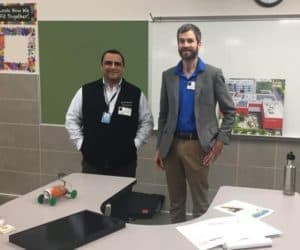Your cart is currently empty!

TEACHING SOLAR POWER TO THE NEXT GENERATION
David Hurtado recently installed 29 SunPower solar panels on the rooftop of his family’s home. The solar power system will offsets about two-thirds of his family’s electricity usage and avoid 9.5 tons of CO2 emissions annually, which is like taking two cars off the road for a year, His daughter so interested in the new…
David Hurtado recently installed 29 SunPower solar panels on the rooftop of his family’s home. The solar power system will offsets about two-thirds of his family’s electricity usage and avoid 9.5 tons of CO2 emissions annually, which is like taking two cars off the road for a year,
His daughter so interested in the new home solar panels that she began talking to her school teacher about solar power. That led to an invitation for us to teach a session about the science of solar energy to the third grade classes at Mott Elementary in Pflugerville this week.
Our project manager Ryan Albert explained how solar panels work, shared some fun facts about solar, and demonstrated a solar rover that really wowed the kids!
Ryan asked the classes what energy sources they know about. Solar and wind power were the most common answers (albeit not the most prevalent energy sources, unfortunately). Several astute students also suggested hydroelectric power and even kinetic energy, as recalled from a science experiment turning a hand crank to power a light bulb.
THE STUDENTS WERE CURIOUS ABOUT ELECTRICITY
We were impressed by all of the insightful and interesting questions we got. In the interest of sharing what’s on the minds of the leaders of tomorrow, here are a few of the questions they asked:
HOW IS A SOLAR PANEL MADE?
Solar panels are made in factories using a complex process with many steps and materials, and the foundation for a solar cell is silicon. Silicon is a naturally occurring element in crystalline form that we would find in nature as a special type of quartz sand. So in a way, solar panels are made from sand!
HOW DOES SAND TURN INTO A SOLAR PANEL?
The sand is purified using a special heater that separates the silicon from other elements. The pure silicon is sliced into thin wafers, layered with metal to conduct electricity, covered with a special anti-reflective glass, and assembled in a frame that typically holds 60 to 72 cells each (learn more).
HOW DOES IT MAKE ELECTRICITY?
When sunlight hits the panel, light particles called photons excite the atoms in the silicon and make them start dancing around. That shakes the electrons loose from the the atom, which creates electricity (learn more).
DOES THE LIGHT BOUNCE BACK OFF A SOLAR PANEL?
Yes!
DO SOLAR PANELS STILL MAKE POWER WHEN IT ISN’T SUNNY?
When it’s cloudy or raining outside, the solar panels will still make electricity but not as much as in full sunlight.
DOES IT WORK AT NIGHT?
No, but you can use solar power to charge batteries during the day and use that battery power after the sun goes down. In West Texas, the wind blows strongest at night, and there are a lot of wind farms there that can make electricity when the sun isn’t shining. Wires carry the electricity to us.
CAN THE MOON OR STARS MAKE ELECTRICITY?
No, the reflected sunlight from the moon is too weak to power a solar panel, and the stars are too far away to give us power.
IS SOLAR ENERGY IN OTHER PARTS OF THE UNIVERSE?
The sun does reach the other planets in our solar system, which means that you can create solar power on other planets. For example, the rovers on Mars are solar-powered (learn more).
HOW DO THE ROVERS ON MARS NOT GET DAMAGED BY THE STORMS?
The rovers are built with very strong and durable materials that are designed to protect them, but the storms on Mars can be very fierce! This summer a big Martian dust storm blocked enough sunlight to keep Opportunity Mars from communicating with us, but NASA scientists are hoping the rover will come back online when the storm clears (learn more).
CAN LIGHTNING POWER A ROVER?
Not with today’s technology. The energy from lightning is too powerful and too fast to power a photovoltaic (PV) panel, but maybe someday we’ll be able to figure out how to harness lightning as an energy source!
CAN FRICTION CREATE ENERGY?
Yes, but not usually enough to meet our electricity needs.
IS ELECTRICITY A SOLID, LIQUID, OR GAS?
Electricity itself is the movement of electrons, so it is not a state of matter (learn more). Instead, it’s more similar to a wave (like radio waves or even light).
It is always fun to engage with young children on energy and science topics, and we are grateful to the Hurtado family and the teachers at Mott for allowing us to participate in the education of your kids!






Leave a Reply